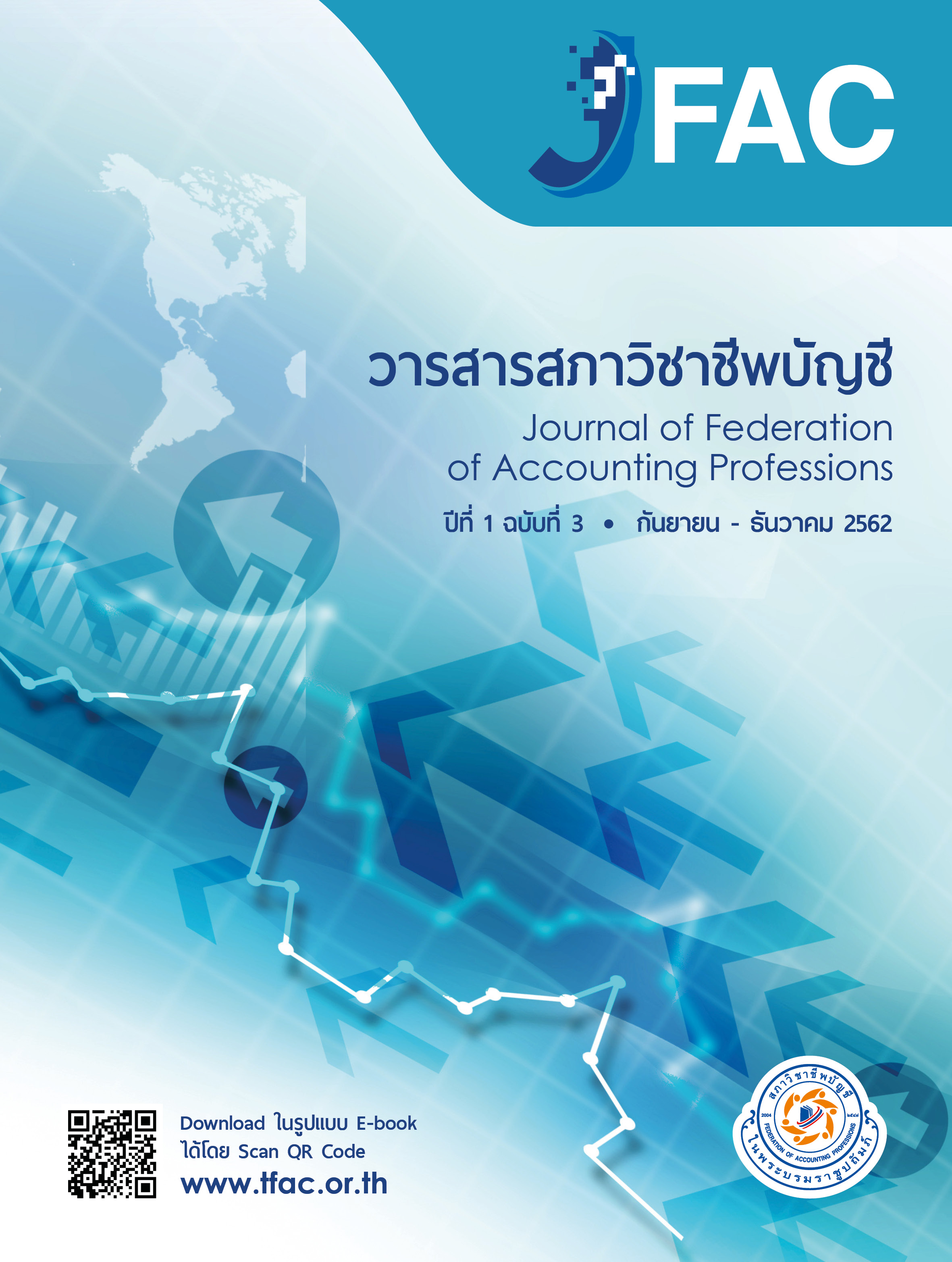การศึกษาประสิทธิภาพและความเสี่ยงของบริษัทที่ดำเนินธุรกิจตามหลักศาสนาอิสลาม: กรณีศึกษาบริษัทในตลาดหลักทรัพย์แห่งประเทศไทย
Main Article Content
บทคัดย่อ
การศึกษานี้มีวัตถุประสงค์เพื่อศึกษาประสิทธิภาพและความเสี่ยงเชิงเปรียบเทียบของหุ้นสามัญระหว่างบริษัทที่ดำเนินธุรกิจตามหลักศาสนาอิสลามกับบริษัททั่วไปในตลาดหลักทรัพย์แห่งประเทศไทย การศึกษานี้วิเคราะห์ข้อมูลของบริษัทที่มีมูลค่าตลาดสูงสุด 50 บริษัทแรกของแต่ละกลุ่ม ตั้งแต่วันที่ 22 เมษายน 2552 ถึงวันที่ 30 ธันวาคม 2559 โดยใช้วิธีการจัดกลุ่มพอร์ตโฟลิโอแบบถ่วงน้ำหนักตามมูลค่าตลาด และแบบถ่วงน้ำหนักเท่ากันเพื่อวิเคราะห์อัตราผลตอบแทนรายวัน และอัตราผลตอบแทนปรับความเสี่ยง และทำการวิเคราะห์ความสัมพันธ์ของอัตราส่วนการเงินต่ออัตราผลตอบแทนของหุ้นสามัญ ผลการศึกษาพบว่า จากการจัดพอร์ต โฟลิโอทั้งสองแบบนั้น ไม่พบความแตกต่างของอัตราผลตอบแทนเฉลี่ยของบริษัททั้งสองกลุ่ม แต่ในกรณีการจัดกลุ่มพอร์ตโฟลิโอแบบถ่วงน้ำหนักตามมูลค่าตลาด การลงทุนในกลุ่มบริษัททั่วไปจะให้ผลตอบแทนแบบปรับความเสี่ยง Sharpe Ratio ที่สูงกว่า ขณะที่การจัดกลุ่มพอร์ตโฟลิโอแบบถ่วงน้ำหนักเท่ากัน การลงทุนในกลุ่มบริษัททั่วไปยังคงให้ผลตอบแทนแบบปรับความเสี่ยง Treynor Ratio และ Jensen Alpha ที่สูงกว่าเช่นกัน นอกจากนี้ยังพบว่าอัตราส่วนราคาต่อมูลค่าตามบัญชีของบริษัทที่ ดำเนินธุรกิจตามหลักศาสนาอิสลามมีผลในทิศทางบวกต่ออัตราผลตอบแทนมากกว่าบริษัททั่วไป
Article Details
เนื้อหาและข้อมูลในบทความที่ลงตีพิมพ์ในวารสารสภาวิชาชีพบัญชี ถือเป็นข้อคิดเห็นและความรับผิดชอบของผู้เขียนบทความโดยตรงซึ่งกองบรรณาธิการวารสารไม่จำเป็นต้องเห็นด้วยหรือร่วมรับผิดชอบใด ๆ
บทความ ข้อมูล เนื้อหา รูปภาพ ฯลฯ ที่ได้รับการตีพิมพ์ในวารสารสภาวิชาชีพบัญชี ถือเป็นลิขสิทธิ์ของวารสารสภาวิชาชีพบัญชี หากบุคคลหรือหน่วยงานใดต้องการนำข้อมูลทั้งหมดหรือบางส่วนไปเผยแพร่ต่อหรือเพื่อกระทำการใดๆ จะต้องได้รับอนุญาตเป็นลายลักษณ์อักษรจากวารสารสภาวิชาชีพบัญชี ก่อนเท่านั้น
เอกสารอ้างอิง
Ahdi, A., Shawkat H., Duc, N. & Soodabeh, S. (2013). How strong are the casual relationships between Islamic stock markets and conventional financial systems? Evidence from linear and nonlinear tests. Journal of International Financial Markets, Institutions and Money, 28.
FTSE Russell. (2016).FTSE SET Shariah Index. Retrieved from http://www.ftse.com/Analytics/ FactSheets
Forte, G. & Miglietta, F. (2007). Islamic mutual funds as faith-based funds in a socially responsible context. Working Paper, Bocconi University.
Habib, M., & Islam, K. (2014). Performance of Shariah Compliant Index: A Comparative Study of India and Malaysia. International Journal of Interdisciplinary and Multidisciplinary Studies (IJIMS), 1(6), 231-241.
Hamada, R. S. (1972). The effect of the firm's capital structure on the systematic risk of common stocks. The Journal of Finance, 27(2), 435-452.
Hayat, R. Kraussl, R. (2011). Risk and return characteristics of Islamic equity funds. Emerging Markets Review, 12, 189-203.
Hussein, K. A. (2004). Ethical Investment: Empirical Evidence from FTSE Islamic Index. Islamic Economics Studies, 12(1), 21-40
Martani, D. & Khairurizka, R. (2009). The effect of financial ratios, firm size, and cash flow from operating activities in the interim report to the stock return. Chinese Business Review, 8(6), 44.
Guruswamy, M. (2014). Turmoil in the world of Islam.Retrieved from http://www.deccanchronicle.com /140614/commentary-op-ed/article/turmoil-world-islam
Nisar, S. (2007). Islamic norms for stock screening. Islamic Banking and Finance Magazine, 12, 95-113
Reddy, K., & Fu, M. (2014). Does shariah compliant stocks perform better than the conventional stocks? A comparative study of stocks listed on the Australian Stock Exchange. Asian Journal of Finance & Accounting, 6(2), 155-170.
S&P Global Ratings. (2016). Islamic Finance Outlook 2017 Edition. Retrieved from https://www. spratings.com/documents/20184/0/Islamic+Finance+Outlook+2017/5abbe572-c826-4622-bd13-1aba725281fc
Sharpe, W. F. (1964). Capital asset prices: A theory of market equilibrium under conditions of risk. The journal of finance, 19(3), 425-442.
Sharpe, W. F., Alexander, G. J., & Bailey, J. V. (1999). Prentice Hall Upper Saddle River. NJ, 1.
Sukmana, R., & Kholid, M. (2012). Impact of global financial crisis on Islamic and conventional stocks in emerging market: an application of ARCH and GARCH method. Asian Academy of Management Journal of Accounting & Finance, 31(2), 357-370.


